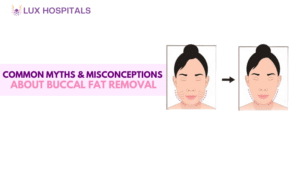Breast Augmentation Myths and Facts: Common Misconceptions

One of the most popular cosmetic treatments in the world is breast augmentation. Despite the fact that millions of women get this procedure every year, there are still a lot of misconceptions and false information surrounding it.
These false beliefs frequently keep people from making wise choices or cause them to have irrational expectations. In this blog, we’ll look at some of the most common myths about breast augmentation, debunk them, and provide you with more details.
Myth 1: Breast Implants Always Look Fake
Fact: Not anymore. With modern surgical techniques and a wide variety of implant options available, breast augmentation can look completely natural. Surgeons consider factors like your body proportions, implant size, shape, and placement to achieve a look that compliments your figure.
Breast augmentation, when done by a qualified plastic surgeon, This surgery enhances your appearance without making it obvious you’ve had work done.
Myth 2: Breast Augmentation Is Only About Vanity
Fact: While many women choose breast augmentation to enhance their appearance, it’s not just about aesthetics. Some opt for the procedure after mastectomy, significant weight loss, pregnancy, or to correct asymmetrical breasts.
Beyond the physical transformation, breast augmentation often improves body image and self-confidence, which are just as important as the aesthetic results.
Myth 3: You Need to Replace Implants Every 10 Years
Fact: There is no strict timeline for replacing breast implants. Many women keep their implants for much longer than 10 years without any problems.
Unless you experience complications like rupture or capsular contracture, replacement may be unnecessary. Regular checkups with your plastic surgeon help monitor the condition of your implants and minimize potential breast augmentation risks.
Myth 4: You Can’t Breastfeed After Breast Augmentation
Fact: Most women with breast implants can breastfeed. The ability to do so depends largely on the surgical technique and the placement of the implants.
If the milk ducts and nerves are not affected during breast augmentation surgery, breastfeeding remains possible. It’s important to discuss your family planning goals with your surgeon beforehand.
Myth 5: Breast Implants Cause Cancer
Fact: There is no direct link between breast implants and breast cancer. Women with implants can still undergo routine breast screenings like mammograms.
But anaplastic large cell lymphoma linked to breast implants (BIA-ALCL) is an uncommon disease that is more frequently connected to specific textured implants. Your doctor will explain all breast augmentation risks and help you choose the safest option.
Myth 6: The Scars Will Be Obvious
Fact: All surgeries leave scars, but breast augmentation scars are usually minimal and well-concealed. Surgeons often place incisions in discrete areas such as under the breast fold, around the areola, or in the armpit.
These scars gradually disappear and are hardly perceptible with the right treatment.
Myth 7: Recovery Is Extremely Painful and Long
Fact: Thanks to advances in surgical techniques, recovery from breast augmentation surgery is typically faster and more comfortable than most people expect.
You may experience mild soreness and swelling, but most patients return to regular routines within a week. Following post-operative care instructions guarantees a less challenging and more seamless recovery.
Myth 8: You Can’t Exercise with Breast Implants
Fact: After a short recovery period, you can resume physical activity, including workouts. When it’s safe to go back to the gym, particularly for high-impact or upper-body workouts, will be determined by your surgeon.
With time and the right treatment, you’ll be able to lead an active lifestyle without any limitations.
Choosing the Right Surgeon Makes All the Difference
The outcome of your breast augmentation is significantly influenced on the ability of your surgeon. Our renowned plastic and cosmetic surgeon at Lux Hospitals, has extensive experience producing results that are tailored to the goals and physique of each patient and appear natural.
The risks of breast augmentation are lessened, recuperation times are shortened, and scarring is lessened thanks to her patient-centered approach and the most recent techniques.
Conclusion:
There’s no one-size-fits-all answer when it comes to breast augmentation, but understanding the facts can help you feel more confident in your decision. Don’t let myths misguide you—talk to an experienced, board-certified surgeon and ask the questions that matter.
If you’re considering breast augmentation surgery, consult specialists at Lux Hospitals for a personalized plan and honest advice.
Frequently Asked Questions
Breast augmentation surgery is generally safe when performed by a qualified, board-certified plastic surgeon. Like any surgery, it does carry some risks, but these are minimized with proper technique, sterile practices, and post-operative care.
While breast implants don’t have an expiration date, most last between 10 and 20 years. Many women keep their implants much longer without issues. Regular follow-ups help monitor implant health.
In most cases, no. If the milk ducts and nerves are not damaged during surgery, you should still be able to breastfeed. Discuss your future family plans with your surgeon during consultation.
Yes, there will be some breast augmentation scars, but experienced surgeons make incisions in discrete areas. Over time, these scars usually fade and become less noticeable.
Common breast augmentation risks include infection, bleeding, capsular contracture, implant rupture, or changes in nipple sensation. A skilled surgeon takes precautions to minimize these.
Most patients return to light activities within a few days and resume everyday routines in about a week. Full recovery and settling of implants may take several weeks to months.
Yes, implants can rupture, though it’s uncommon. Saline implants deflate and are safely absorbed by the body. Silicone implants may require an MRI to detect rupture. If a rupture occurs, surgical removal or replacement is recommended.
Modern implants are designed to mimic the look and feel of natural breast tissue. Placement technique and implant type also contribute to achieving this natural feel.




















